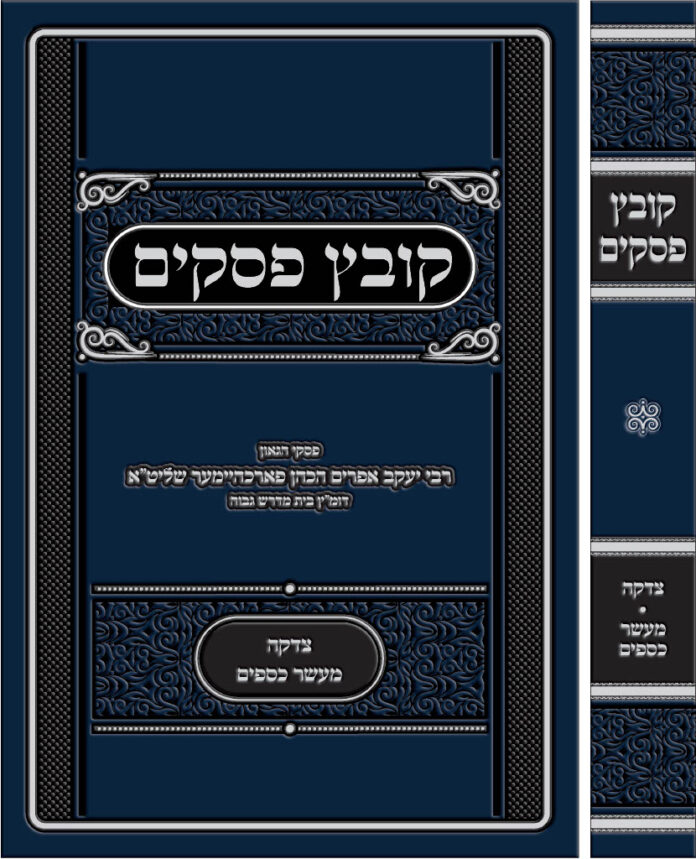
By Rabbi Yair Hoffman for 5tjt.com
PROBLEM: For some reason, practical seforim on Tzedakah halachos and rulings are few and far between. RESOLUTION: With the new sefer entitled, “Kovaitz Psakim” including rulings from Rav Yaakov Forcheimer shlita, one of the leading Rabbonim and Poskim in Lakewood, New Jersey, this problem is solved. It is an exceptional sefer that is simulateniously well organized, filled to the brim with remarkable nuggets of psakim, and an absolute pleasure to learn.
This 369 page sefer belongs in every Torah home and will not only enhance one’s personal observance of Tzedakah – it will entirely redefine it.
FASCINATING NUGGETS
What are some of the fascinating nuggets contained within the sefer? If you don’t have money on you, but you do have money in the car. Are you obligated to go out to the car and get that money? It depends if it is easy to get or not. If it is easy – then yes, you are obligated to get it (p. 121).
What about the somewhat touchy issue about receiving a substantial Tzedakah allotment from a married woman? The author deals with it well (see p. 177). He also has a ruling from Rav Reuvain Feinstein shlita from his father zatzal that it is entirely lechatchila when the woman works out of the home herself. If one received such a donation from the wife where it is not the case – Rav Forcheimer ruled that it does not need to be returned.
WHO IS AN ANI?
The entire chapter three deals with who is an “ani” that is eligible for Tzedakah. If the person has substantial savings can he take Tzedakah? Answer: No. What about enough savings for a “rainy day? “ Answer: Yes, he can. What are the exact guidelines? Good question – learn chapter three.
WHO IS A RELATIVE?
What is the definition of a Karov – a relative, for purposes of preferential treatment? ANSWER: Anyone who is pasul l’aidus – ineligible to testify (p. 151). What about a friend? Yes that also falls under the rubric of Karov. (This reviewer once posed a similar question to Rav Dovid Feinstein zt”l in regard to the parameters of a Karov on Kesuvos 52b – while driving him to a moetzes meeting. Rav Feinstein responded that regarding that Gemorah – it would be anyone that you would invite to a wedding.)
TO JUST ANYONE?
Is one always permitted to distribute Tzedakah funds to just anyone? No- not really. A city such as Lakewood that has a Vaad HaTzedakah that gives out letters – if an ani has such a letter – he should give. But what about a bochur with no letter that comes from a far distance? Rav Forcheimer ruled that one should avoid giving him actual Tzedakah funds (p. 144). Elsewhere, the author cites Poskim that rule to give a quarter from one’s own money.
Before anyone comes down on Rav Forcheimer for being too harsh with this last psak, it would behoove the reader to know that the entire chapter four reminds this reviewer of a Lawrence Gvir who wished to produce a documentary on Tzedakah. He offered one hundred dollars for 15 minute interviews of various people that collect each week in shuls for Tzedakah – provided that the collector tells the absolute truth. The interview went something like this:
Q: Who are you collecting for? Hachnasas Kallah.
Q: Who is the Kallah? It is my Kallah.
Q: Mazel Tov! Where is she from? I do not know yet.
Q: I see. How much do you collect in an average week? Between $100 and $150 dollars a day. Sometimes $200.
Q: How long does your shacharis route at the various shuls take you? Between three and four hours.
Q: Does your driver get a set fee or a percentage? A percentage. But sometimes the three of us can agree to give him the lower of a set fee or a percentage.
The Gvir gave the collector the $100. And we see from this story that Rav Forcheimer shlita has a lot of wisdom in addition to being a remarkably outstanding Talmid Chochom.
There are also very deep sugyos in Tzedakah that are clearly illuminated throughout the Sefer. Many people are familiar with the debate between the Vilna Gaon and the Shulchan Aruch in regard to whether Maaser is actually 20% or 10%. It is in Rabbi Kiffel’s Sefer where we are privy to both the Chofetz Chaim’s method of understanding the debate, as well as the Steipler’s and which Gedolim kept which method. (pp. 353-354).
May yartzeit donations come from Maaser? Rav Nissim Karelitz zt”l (p. 326) ruled, “no.”
HUGE INSIGHTS
Are there huge insights found in the Sefer? Absolutely. On page 150, we find rulings that all of the rulings in Shulchan Aruch about which ani receives precedence over another are only when all other factors are equal. However, if someone lower on the list has a greater debt and less of an ability to gather tzedakah funds – the person lower on the list gets bumped up higher. Although to some people this may seem to be intuitive, one does wonder why this was not discussed by earlier Poskim.
This reviewer was also quite happy to see that the author, Rav Shloime Kiffel, quotes from Rav Shimon Brecher z’l’s posthumous sefer (published by his sons) with hundreds of psakim from Rav Chaim Kanievsky zt”l on Tzedakah entitled, “Shamanu Kain Ra’inu.” For example, Rav Chaim Kanievsky zt”l ruled that maaser funds can be used to print seforim if there will be a universal benefit from the sefer (p.346). The author deals with the various rulings about the particulars involved.
The sefer is now available in finer seforim stores, but be warned: It will soon be sold out.
As reported by VINnews
